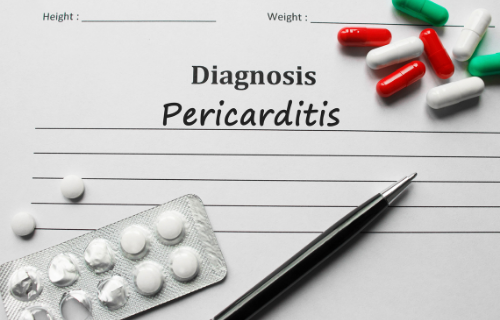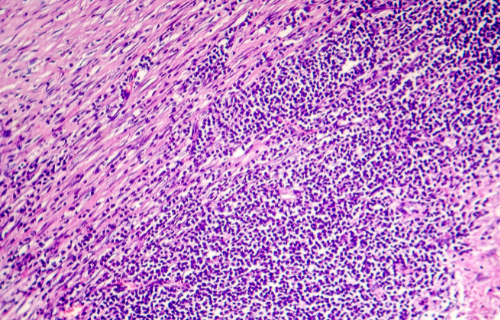Difference Between Pericarditis and Costochondritis

What is Pericarditis
Definition
The fluid-filled sac that protects and encloses the heart is called a pericardium. When this sac becomes inflamed, and blood and fluid leaks into it, this is called pericarditis.
Causes and risk factors
The exact causes of pericarditis are often unclear, but it can result from a viral or bacterial infection. Pericarditis is often an idiopathic condition but can also be a complication of percutaneous procedures (often used to unblock arteries), cardiac surgery or radiation therapy.
Diagnosis
As a first step, the doctor may listen to your heart to listen for any abnormalities in the sound it makes. Afterwards, the doctor may run some blood tests, do a chest X-ray, echocardiogram, or electrocardiogram (ECG) to test for any abnormalities in the heart function.
Symptoms
The clinical description of pericarditis is as a sharp, pleuritic pain. Typically, pain associated with acute pericarditis is sharp, starts abruptly and can vary in duration and intensity with changes in position. It can spread and radiate to the trapezius ridge and down the arm. The symptoms can get worse with recurrency.
Complications
Pericarditis is often benign and can resolve on its own. However, on occasion further complications can arise such as constrictive pericarditis, pericardial effusion and cardiac tamponade, these conditions can increase morbidity and mortality chances.
Treatment
Outpatient interventions (e.g. painkillers and anti-inflammatory medication) are often sufficient to treat discomfort associated with pericarditis.
If pericarditis is caused by a bacterial infection, then antibiotics are prescribed otherwise colchicine or steroids can be used.
Sometimes surgical interventions (e.g. pericardiectomy or fluid drainage) may be necessary.

What is Costochondritis
Definition
The inflammation of the cartilage that connects the ribs to the sternum is called costochondritis.
Causes and risk factors
Causes of costochondritis are not known but certain conditions are known to trigger it. These include bacterial and fungal infections, chest injury, respiratory tract infection, physical strain or arthritis. In adolescents, chest pains arise from costochondritis 10 to 30% of the time. Costochondritis can occur due to a vitamin D deficiency.
Diagnosis
A physical exam and physical manipulation can be used to identify the areas of swelling and tenderness along the breastbone and ribcage. As there is no straightforward diagnostic method, the doctor may first rule out heart and vascular conditions, lung conditions, digestive problems, and musculoskeletal issues using tests including X-ray, CT scan, MRI or an electrocardiograph.
Symptoms
Chest pains starting from the left side and radiates throughout the chest can be symptomatic of costochondritis. The pain can sometimes spread to the stomach and back.
[Complications
Complications from Costochondritis can result in conditions including rheumatoid arthritis, osteoarthritis or, in rare occasion, a chest tumor.
Treatment
Over-the-counter pain medications, ice pack or heating pad can be used to manage the symptoms. Physical therapy can also relieve the discomfort. If these fail, an anti-inflammatory injection (Corticosteroids) or implanting a nerve stimulation device (TENS) may help. On rare cases, surgery may be performed.
Difference between Pericarditis and Costochondritis
Definition
Pericarditis is a cardiac system condition that involves the inflammation of the pericardium. Costochondritis is a musculoskeletal system condition where the cartilage connecting the ribs to the sternum is inflamed.
Causes
Pericarditis can result from viral, bacterial or fungal infections, and autoimmune conditions including sarcoidosis. The causes of costochondritis are not known but some conditions can trigger it such as bacterial and fungal infection, physical strain and arthritis.
Symptoms
Pericarditis may present as a sharp chest pain that can spread to the shoulder, back and neck. Costochondritis may be characterized by swelling and inflammation of the affected joint.
Treatment
Pericarditis is treated with pain medicine, corticosteroids and, occasionally, can be treated by performing a pericardiectomy or surgically draining the fluid. Costochondritis is treated with over-the-counter medication, nerve stimulation or, in acute cases, removal of the affected cartilage.
Complications
Pericarditis can lead to cardiac tamponade, pericardial effusion or constrictive pericarditis. Costochondritis can sometimes be associated with rheumatoid arthritis, and occasionally a chest tumor.
Mortality rate
The chance of death from pericarditis is low with a mortality of approximately 1.1%, this increases when pericarditis results from a bacterial infection such as tuberculosis or it accompanies HIV (40% mortality rate). While one is unlikely to die from costochondritis, the complications that arise from this condition can be deadly.
Table comparing Pericarditis and Costochondritis

Summary of Pericarditis and Costochondritis
- Pericarditis results from the inflammation of the pericardial membrane.
- Costochondritis is an inflammation of the cartilage connecting the ribs to the breastbone.
- Both pericarditis and costochondritis are not fatal and, when mild, can be treated with over-the-counter pain medication.
FAQ
Can pericarditis be mistaken for costochondritis?
When the pain and associated symptoms spread from the point of origin the symptoms of these conditions can confusing.
Is it my heart or costochondritis?
Because costochondritis presents as pain is in the chest, it can be misdiagnosed as a heart attack. However, additional tests (including blood tests, electrocardiogram, MRI) can help clear up this confusion.
What can costochondritis be mistaken for?
Costochondritis can be confused with Tietze’s syndrome. Tietze’s syndrome is very rare and more common in adults younger than 40. Both conditions can have similar symptoms including the inflammation of the costochondral joint. Tietze’s syndrome symptoms include swelling of the chest which may outlast the pain and tenderness. Costochondritis often affects adults 40 years old and above.
- Difference Between Pericarditis and Costochondritis - April 8, 2022
- Difference Between Fibrinolysis and Thrombolytics - March 29, 2022
- Difference Between Necrosis and Infarction - March 18, 2022
Search DifferenceBetween.net :
Leave a Response
References :
[0]Cleveland Medical Professional. “Pericarditis: Symptoms, Causes, Treatments.” Cleveland Clinic, https://my.clevelandclinic.org/health/diseases/17353-pericarditis. Accessed: 2 February 2022.
[1]Cornell, Weill. “Pericardial Diseases.” Weill Cornell Medicine, New York Presbyterian, https://weillcornell.org/pericardial-diseases.
[2]Imazio, M., and F. Gaita. “Diagnosis and Treatment of Pericarditis.” Heart, vol. 101, no. 14, 2015, pp. 1159–68, doi:10.1136/heartjnl-2014-306362.
[3]Kiniksa Pharmaceuticals Ltd. “Recurrent Pericarditis Information for Healthcare Professionals.” Kiniksa Pharmaceuticals, The Heart of Inflammation, https://www.heartofinflammation.com/#diagnosis-and-treatment. Accessed: 2 February 2022.
[4]Kytö, Ville, et al. “Clinical profile and influences on outcomes in patients hospitalized for acute pericarditis.” Circulation, vol. 130, 2014, pp. 1601–06, doi:10.1161/CIRCULATIONAHA.114.010376.
[5]Lewinter, M. M., et al. “Pericardial Diseases.” Heart Disease: A Textbook of Cardiovascular Medicine, edited by P. Libby et al., 12th ed., Elsevier, pp. 1615–77.
[6]Mayo Clinic Staff. “Pericarditis.” Mayo Clinic, Mayo Foundation for Medical Education and Research, 28 Jan. 2022, https://www.mayoclinic.org/diseases-conditions/pericarditis/symptoms-causes/syc-20352510. Accessed: 2 February 2022.
[7]Mayosi, B.M., et al. “Mortality in patients treated for tuberculous pericarditis in sub-Saharan Africa.” SAMJ, vol. 98, no. 1, 2008, pp. 1–5.
[8]NHS. “Pericarditis.” NHS Choices, NHS, 21 Sept. 2020, https://www.nhs.uk/conditions/pericarditis/. Accessed: 2 February 2022.
[9]Oh, R.C., and J.D. Johnson. “Chest pain and costochondritis associated with vitamin D deficiency: A report of two cases.” Case Reports in Medicine, vol. 2012, 2012, doi:10.1155/2012/375730.
[10]Proulx, Anne M., and T.W. Zryd. “Costochondritis: diagnosis and treatment.” American Family Physician, vol. 80, no. 6, 2009, pp. 617–20.
[11]Troughton, Richard W., et al. “Pericarditis.” Lancet, vol. 363, no. 9410, 2004, pp. 717–27, doi:10.1016/S0140-6736(04)15648-1.
